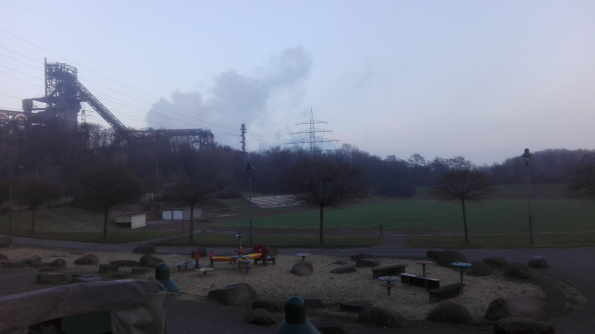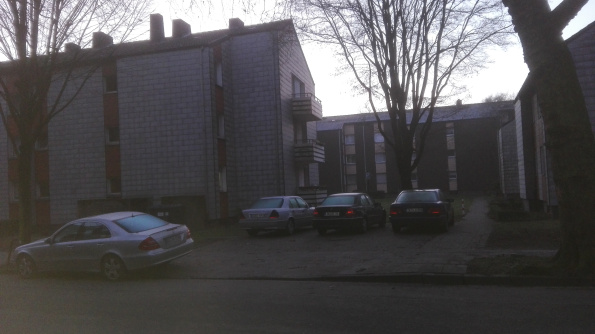Hi from Marxloh! I’m finding myself with junior in Marloh (to watch Schalke ’04)and it happens to be the most steampunk city I’ve ever been. It is part of Duisberg, a city inside the ‘Ruhrgebiet’, the German equivalent of the USA rust belt except that it’s not rusty but Europe’s largest steelhub (according to a sign along the road). Marxloh, which became a suburb for labourers can nowadays really be called Little Turkey (with capitals. It’s population increased from 352 in 1895 to 35.872 only twenty years later, in 1925. Nowadays, 18.000 people are living here, more than half of them ‘foreigners’ (mainly Turks and on the main street Turkish is omnipresent). But the number of inhabitants is fortunately increasing again. The main street (Wellenstrasse) is great. When there is one bridal shop in town it is probably thriving. When there are two in town, both of them will be struggling. But when you have 20 – people will come flocking to your bridal hub, which seems to have happened to the Wellenstrasse. The bridal shops are Turkish but the style is very much the typically western romantic white gown style (and an occasional suit for the groom, too). Also lots of extreme bling shops (and small supermarkets with a larger array of vegetables than large supermarkets in the Netherlands). The bling contributes with the steel industry to the steampunk feeling.
Topics:
Merijn T. Knibbe considers the following as important: Uncategorized
This could be interesting, too:
tom writes The Ukraine war and Europe’s deepening march of folly
Stavros Mavroudeas writes CfP of Marxist Macroeconomic Modelling workgroup – 18th WAPE Forum, Istanbul August 6-8, 2025
Lars Pålsson Syll writes The pretence-of-knowledge syndrome
Dean Baker writes Crypto and Donald Trump’s strategic baseball card reserve

Hi from Marxloh! I’m finding myself with junior in Marloh (to watch Schalke ’04)and it happens to be the most steampunk city I’ve ever been. It is part of Duisberg, a city inside the ‘Ruhrgebiet’, the German equivalent of the USA rust belt except that it’s not rusty but Europe’s largest steelhub (according to a sign along the road). Marxloh, which became a suburb for labourers can nowadays really be called Little Turkey (with capitals. It’s population increased from 352 in 1895 to 35.872 only twenty years later, in 1925. Nowadays, 18.000 people are living here, more than half of them ‘foreigners’ (mainly Turks and on the main street Turkish is omnipresent). But the number of inhabitants is fortunately increasing again. The main street (Wellenstrasse) is great. When there is one bridal shop in town it is probably thriving. When there are two in town, both of them will be struggling. But when you have 20 – people will come flocking to your bridal hub, which seems to have happened to the Wellenstrasse. The bridal shops are Turkish but the style is very much the typically western romantic white gown style (and an occasional suit for the groom, too). Also lots of extreme bling shops (and small supermarkets with a larger array of vegetables than large supermarkets in the Netherlands). The bling contributes with the steel industry to the steampunk feeling. There also is a smashing community sports stadium from my favorite architectural era, the twenties (1923-1925, to be precise, see the first fotograph)! At 7:30 you can already get a cup of coffee in the café of the stadion, from two nice turkish women. One had just become grandmother, great picture from the child on the bar. The hamburgers served (I did not take one at that time, of course!) are not labelled ‘halal’ but the price list indicates not if the stuff in it is possibly an allergen but if it is chicken or beef. Mind the doors of the stadion, however (second photograph). The modern buildings of Marxloh are somewhat bland (third fotograph). Not too much variety in cars there, too, only one proverbial German, brand…:).
Our hotel turns out to be the carnaval hotspot of this neighborhood, so I got a handshake of what looked like Prinz Carnaval at the the total traditional Carnaval evening, including an standup ‘August’ (where do you think the USA standup comedian tradition originates from…) telling jokes. Alltogether, the whole area does vibrate quite a bit! I mean, letting tall chimneys spawn smoke is not the sustainable thing to do, but sipping coffee in a café which is open on a Saturday morning 7:30, when the first sporters are coming in and watching the steelwork producing does give you a feeling of action. And oh, can we please build sports stadions like they did in the twenties, again. Also, according to Wikipedia, there are supposed to be ‘no go areas’ here, I’ll keep searching for them.

